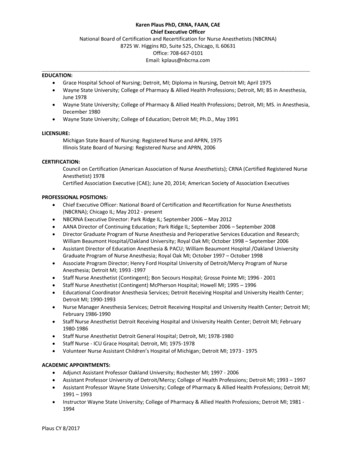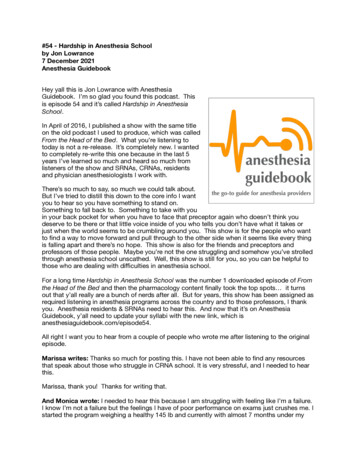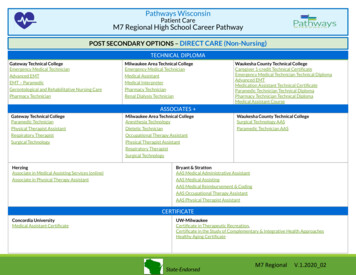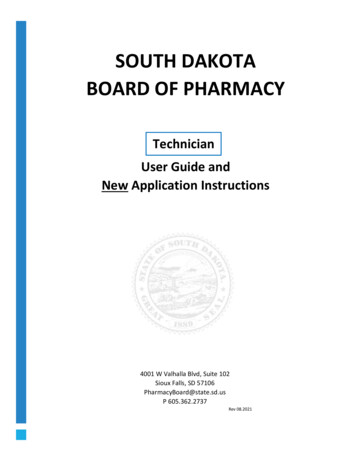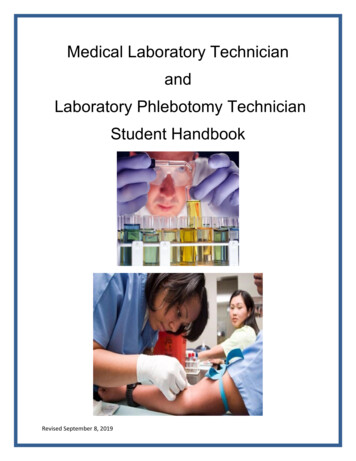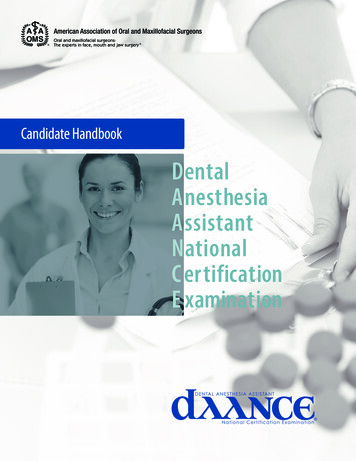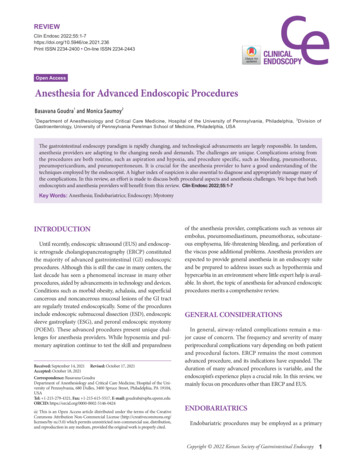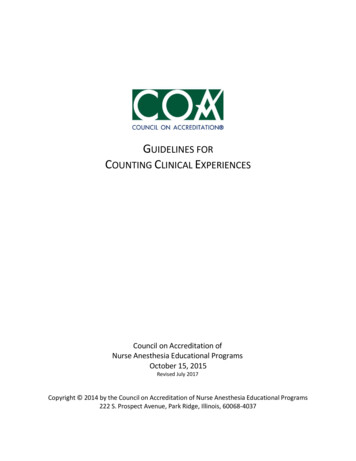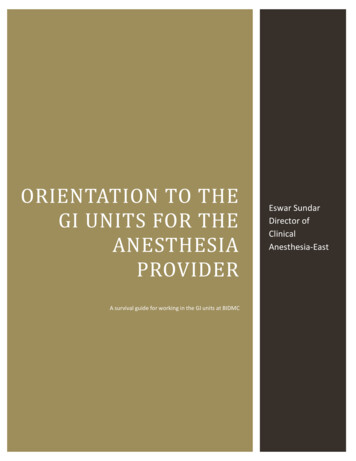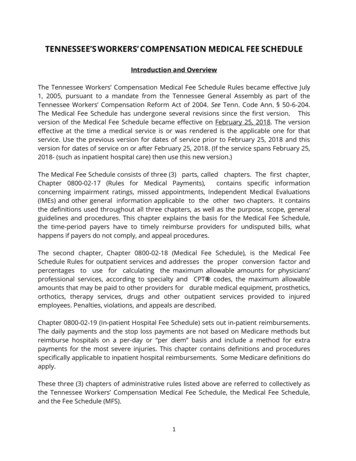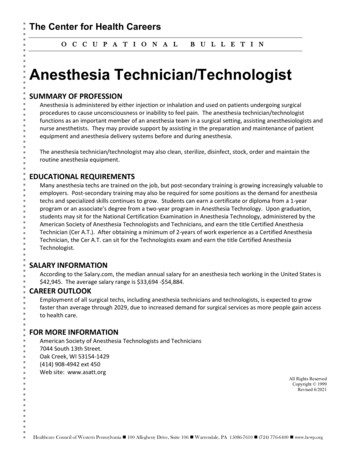
Transcription
The Center for Health CareersO C C U P A T I O N A LB U L L E T I NAnesthesia Technician/TechnologistSUMMARY OF PROFESSIONAnesthesia is administered by either injection or inhalation and used on patients undergoing surgicalprocedures to cause unconsciousness or inability to feel pain. The anesthesia technician/technologistfunctions as an important member of an anesthesia team in a surgical setting, assisting anesthesiologists andnurse anesthetists. They may provide support by assisting in the preparation and maintenance of patientequipment and anesthesia delivery systems before and during anesthesia.The anesthesia technician/technologist may also clean, sterilize, disinfect, stock, order and maintain theroutine anesthesia equipment.EDUCATIONAL REQUIREMENTSMany anesthesia techs are trained on the job, but post-secondary training is growing increasingly valuable toemployers. Post-secondary training may also be required for some positions as the demand for anesthesiatechs and specialized skills continues to grow. Students can earn a certificate or diploma from a 1-yearprogram or an associate’s degree from a two-year program in Anesthesia Technology. Upon graduation,students may sit for the National Certification Examination in Anesthesia Technology, administered by theAmerican Society of Anesthesia Technologists and Technicians, and earn the title Certified AnesthesiaTechnician (Cer A.T.). After obtaining a minimum of 2-years of work experience as a Certified AnesthesiaTechnician, the Cer A.T. can sit for the Technologists exam and earn the title Certified AnesthesiaTechnologist.SALARY INFORMATIONAccording to the Salary.com, the median annual salary for an anesthesia tech working in the United States is 42,945. The average salary range is 33,694 - 54,884.CAREER OUTLOOKEmployment of all surgical techs, including anesthesia technicians and technologists, is expected to growfaster than average through 2029, due to increased demand for surgical services as more people gain accessto health care.FOR MORE INFORMATIONAmerican Society of Anesthesia Technologists and Technicians7044 South 13th Street.Oak Creek, WI 53154-1429(414) 908-4942 ext 450Web site: www.asatt.orgAll Rights ReservedCopyright 1999Revised 6/2021Healthcare Council of Western Pennsylvania 100 Allegheny Drive, Suite 106 Warrendale, PA 15086-7610 (724) 776-6400 www.hcwp.org
The Center for Health CareersO C C U P A T I O N A LB U L L E T I NArt TherapistsSUMMARY OF PROFESSIONArt therapists are professionals trained in both art and therapy for treating the developmentally, medically,educationally, socially or psychologically impaired. Art therapy integrates the fields of human development,visual art (drawing, painting, sculpture, and other art forms), and the creative process with models ofcounseling and psychotherapy. Art therapists work with people of all ages and backgrounds who are seekingpersonal growth or who may be struggling with a variety of difficulties. They may provide services toindividuals, couples, family groups and communities.Art therapists may work in a variety of settings including hospitals, clinics, residential treatment centers,shelters, schools, and elder care facilities. They may also work in private practice. If the idea of offeringguidance and support using a wide variety or art materials appeals to you, art therapy may be the career foryou.EDUCATIONAL REQUIREMENTSEntry into the profession of art therapy is at the master’s level. Students wishing to become an art therapistmust first obtain a master’s degree in a program accredited by the Education Committee of the American ArtTherapy Association and the Accreditation Council for Art Therapy Education. Upon completion of a master’sprogram and postgraduate supervised experience, art therapists may apply for registration to earn theRegistered Art Therapist credentialing (ATR). Registered art therapists can then take and pass a writtenexamination to become Board Certified (ATR-BC). Some art therapists may choose to complete theircredentialing by demonstrating substantial supervision qualifications to earn the Certified SupervisorCredential (ATCS).SALARY INFORMATIONAccording to Payscale.com, the median salary for an art therapist is 46,128 with a range of 37,000- 63,000.CAREER OUTLOOKArt therapy is a growing field. Employment is expected to increase as professionals and clients recognize thebenefits of this therapy. Those art therapists who are registered and board certified have a distinct advantagein gaining employment.FOR MORE INFORMATIONAmerican Art Therapy Association, Inc.11160-C1 South Lakes Drive, Suite 813Reston, VA 201911-888-290-0878Web site: www.arttherapy.orgAll Rights ReservedCopyright 1999Revised 6/2021Healthcare Council of Western Pennsylvania 100 Allegheny Drive, Suite 106 Warrendale, PA 15086-7610 (724) 776-6400 www.hcwp.org
The Center for Health CareersO C C U P A T I O N A LB U L L E T I NAthletic TrainerSUMMARY OF PROFESSIONBehind virtually every star athlete who makes the winning point on a Saturday afternoon, a dedicated athletictrainer stands on the sidelines. As health care professionals who focus specifically on athletes and otherphysically active people, athletic trainers play an integral role in helping people meet their physical fitnessgoals.Athletic trainers are skilled in all phases of an athlete’s medical care, including the prevention of injuriesthrough proper conditioning, recognition and evaluation of injuries, emergency care and rehabilitation. Theymay also organize nutritional diets and meals for athletes in training. Some athletic trainers do work on theprofessional level, but the majority are employed by high schools, colleges and universities, sports medicineclinics and businesses. If you have leadership skills, dedication and an interest in sports and physical fitness,you may enjoy an exciting career as an athletic trainer.EDUCATIONAL REQUIREMENTSA bachelor’s degree in athletic training, exercise science or physical education is usually the minimumrequirement. Certified programs include academic courses such as anatomy, physiology, biomechanics andpsychology, as well as 1,500 hours of supervised clinical experience. Graduates who pass the NationalAthletic Trainers’ Associations Board of Certification examination are awarded the Certified Athletic Trainercredential (ATC). Those interested in college teaching positions, orthopedics and physical therapy can pursuea master’s degree.SALARY INFORMATIONThe salary of an athletic trainer depends on experience and job responsibilities, and varies by job setting.Because some work with teams during sport events, they might be required to work evenings or weekends,and travel often. Median annual earnings for athletic trainers were 48,440 in 2019, according to the USDepartment of Labor’s Bureau of Labor Statistics. The lowest 10 percent earned less than 31,300, and thehighest 10 percent earned more than 73,470.CAREER OUTLOOKThe Bureau of Labor Statistics projected employment of athletic trainers is expected to grow much faster thanthe average for all occupations from 2019 to 2029, at a rate of 16%.FOR MORE INFORMATIONThe National Athletic Trainers’ Association2952 Stemomons FreewayDallas, TX 75247-6196(214) 637-6282Web site: www.nata.orgAll Rights ReservedCopyright 1999Revised 2/2021Healthcare Council of Western Pennsylvania 100 Allegheny Drive, Suite 106 Warrendale, PA 15086-7610 (724) 776-6400 www.hcwp.org
The Center for Health CareersO C C U P A T I O N A LB U L L E T I NAudiologistsSUMMARY OF PROFESSIONAudiologists are educated in the study of normal hearing processes and hearing loss. They determine if aperson has hearing loss, what type of loss it is, and how to make the best use of remaining hearing. They useaudiometers, computers, and other testing devices to measure the person’s hearing and balance ability,ability to distinguish between sounds, and the nature and extent of hearing loss.Audiologists evaluate various factors that could affect a person’s hearing, including patients’ psychologicalhealth, trauma at birth, viral infections, genetic disorders, environmental factors, and aging. Treatment mayinclude cleaning the ear canal, use of hearing aids, or use of cochlear implants. Audiologists work in a varietyof settings including schools, hospitals, hearing centers and private practice.EDUCATIONAL REQUIREMENTSAudiologists are required to have a doctoral degree in audiology (Au.D.) Coursework includes anatomy,physiology, genetics, communication development, and usually includes clinical experience.All 50 states now require licensure, although the requirements for licensure vary by state. Audiologists canearn the Certificate of Clinical Competence in Audiology (CCC-A). To earn the title CCC, a person must have agraduate degree and 375 hours of supervised clinical experience, complete a 36-week postgraduate clinicalfellowship, and pass a written examination.SALARY INFORMATIONIn 2019, a typical audiologist working in the United States earned a median base salary of 77,600, accordingto the United States Department of Labor’s Bureau of Labor Statistics. The lowest 10 percent earned less than 54,010, and the highest 10 percent earned more than 120,750.CAREER OUTLOOKEmployment of audiologists is expected to grow much faster than the average for all occupations through theyear 2029. Because hearing loss is strongly associated with aging, rapid growth in the population age 55 andover will cause the number of persons with hearing impairment to increase markedly.FOR MORE INFORMATIONThe American Speech-Language-Hearing Association2200 Research Boulevard, Rockville, Maryland 20850Phone: (301) 296-5700Website: www.asha.orgAll Rights ReservedCopyright 1999Revised 2/2021Healthcare Council of Western Pennsylvania 100 Allegheny Drive, Suite 106 Warrendale, PA 15086-7610 (724) 776-6400 www.hcwp.org
The Center for Health CareersO C C U P A T I O N A LB U L L E T I NBiomedical EngineeringSUMMARY OF PROFESSIONBiomedical engineering or bioengineering, combines biology, chemistry, physics, technology, science, andmedicine to solve biological and medical problems. A biomedical engineer should first plan to become a goodengineer who then acquires a working understanding of the life sciences. These professionals design anddevelop technology and devices that are responsible for improvements in healthcare. Biomedical engineersmay work in a number of capacities including; designing machines that save lives, such as defibrillators orheart-rate monitors; work to solve health problems related to the workplace; they may design betterprotection against radiation, or design artificial body parts or; develop medical and surgical instrumentationsystems. They may also carry out research in the medical field providing ideas for innovative projects.In this field there is continual change and creation of new areas due to rapid advancement in technology.Some of the well-established specialty areas within the field of biomedical engineering are:bioinstrumentation, biomaterials, biomechanics, clinical engineering, medical imaging, rehabilitationengineering and bioenvironmental engineering. Often these specialists work together on projects sharinginformation, techniques and ideas.The biomedical engineer may work in hospitals, research facilities, industry, and government agencies. Thefield requires analytical and critical-thinkers who are willing to solve difficult problems in the healthcare field.EDUCATIONAL REQUIREMENTSThe minimum education requirement for biomedical engineering is a bachelor’s degree from an accreditedprogram. However, unlike other engineering specialties, a graduate degree is recommended and oftenrequired for many entry-level jobs.SALARY INFORMATIONAccording to the United States Department of Labor’s Bureau of Labor Statistics, the median salary for abiomedical engineer was 92,620 in 2020. The lowest 10 percent earned less than 56,590, and the highest10 percent earned more than 149,440.CAREER OUTLOOKEmployment of biomedical engineers is expected to increase as fast as the average for all occupations through2029, at a rate of 5%, according to the Bureau of Labor Statistics. The aging of the population and the focuson health issues will drive demand for better medical devices and equipment designed by biomedicalengineers.FOR MORE INFORMATIONBiomedical Engineering Society8401 Corporate Dr., Suite 225, Landover, MD 20785-2224Ph: 301.459.1999 Website: www.bmes.orgAll Rights ReservedCopyright 1999Revised 6/2021Healthcare Council of Western Pennsylvania 100 Allegheny Drive, Suite 106 Warrendale, PA 15086-7610 (724) 776-6400 www.hcwp.org
The Center for Health CareersO C C U P A T I O N A LB U L L E T I NBiomedical Equipment TechnicianSUMMARY OF PROFESSIONWith increasing advances in medical technology, the need for health professionals to evaluate, inspect, repair,install and manage biomedical equipment and instruments is on the rise. Biomedical equipment techniciansare responsible for maintaining this equipment for use by health professionals, as well as for scientists andengineers who research sicknesses and diseases. Types of biomedical equipment include cardiac monitors,electrocardiographs, blood gas analyzers, x-ray units and anesthesia apparatus.Biomedical equipment technicians should enjoy mechanical, electrical and electronic work. Communicationskills are critical for these professionals to instruct others on the proper use of such sophisticated equipmentand to describe breakdowns to manufacturers. A good bedside manner is also valuable, as many technicianswill come in contact with patients on a regular basis. Courses in anatomy and physiology, biology, physics,algebra and trigonometry will prepare you for this cutting-edge, high-tech career.EDUCATIONAL REQUIREMENTSStudents interested in becoming biomedical equipment technicians must earn a minimum of an associate’sdegree in biomedical equipment technology or biomedical engineering. However, a bachelor’s degree ineither program is ideal. Certification is not required, but may lead to higher earning potential. Candidatescan earn certification by successfully passing a national exam and meeting the educational and experiencerequirements. Certification credentials include Certified Biomedical Equipment Technician (CBET), CertifiedRadiology Equipment Specialist (CRES), or Certified Laboratory Equipment Specialist (CLEB).SALARY INFORMATIONAccording to the United States Department of Labor’s Bureau of Labor Statistics, the median salary for atypical biomedical equipment technician is 51,610. The lowest 10 percent earned less than 31,180 and thehighest 10 percent earned more than 84,720, with the remaining 80% of earners falling somewhere inbetween.CAREER OUTLOOKAccording to the Bureau of Labor Statistics, employment of biomedical equipment technicians is expected togrow as fast as the average of all careers through 2029.FOR MORE INFORMATIONAssociation for the Advancement of Medical Instrumentation (AAMI)1110 N. Glebe Road, Suite 220Arlington, VA 22201-4795(703) 525-4890Web site: www.aami.orgAll Rights ReservedCopyright 1999Revised 6/2021Healthcare Council of Western Pennsylvania 100 Allegheny Drive, Suite 106 Warrendale, PA 15086-7610 (724) 776-6400 www.hcwp.org
The Center for Health CareersO C C U P A T I O N A LB U L L E T I NCardiovascular TechnicianSUMMARY OF PROFESSIONEvery surgeon who must investigate potential vascular defects or perform heart surgery needs a qualifiedteam of professionals for support. The cardiovascular technologist, trained in a variety of invasive andnoninvasive procedures to diagnose and treat ailments of the heart and blood vessels, is an integral memberof this team.Cardiovascular technologists operate sophisticated equipment during complicated and delicate proceduressuch as heart catheterization and balloon angioplasty to help physicians diagnose and treat patients. Theymonitor patients’ blood pressure and heart rate using electrocardiogram equipment, and can also prepareand monitor patients during open-heart surgery and pacemaker implantation. These professionals must bereliable, have mechanical aptitude to efficiently operate ultrasound instrumentation and electrocardiographequipment, and be able to follow detailed instructions. They also must be caring and compassionate whenworking with patients to perform tests or prepare them for surgery. Many of these patients have severeheart problems that may be life threatening.EDUCATIONAL REQUIREMENTSCardiovascular technologists usually complete a 2-year training program. One year is dedicated to corecourses, followed by a year of specialized instruction in invasive, noninvasive or noninvasive peripheralcardiology. Professionals already trained in a health career only require the year of specialized instruction.Occasionally, these professionals can be trained on the job if they have other health care-related experience.Graduates from accredited programs can register with the American Registry of Diagnostic MedicalSonographers or Cardiovascular Credentialing International.SALARY INFORMATIONMedian annual earnings of cardiovascular technologists was 59,100 in 2020. The lowest 10 percent earnedless than 30,140, and the highest 10 percent earned more than 96,790, with most cardiovasculartechnologists making something in between.CAREER OUTLOOKEmployment of cardiology technologists is expected to grow much faster than the average for all occupationsthrough 2029 in part because of an aging population, which has a higher incidence of heart problems. Thefield is a small one, however, so the actual number of available jobs will continue to be smaller than average.FOR MORE INFORMATIONAlliance of Cardiovascular ProfessionalsPO Box 2007Midlothian, VA 23113(804) 632-0078(804) 639-9212 faxWeb site: www.acp-online.orgAll Rights ReservedCopyright 1999Revised 6/2021Healthcare Council of Western Pennsylvania 100 Allegheny Drive, Suite 106 Warrendale, PA 15086-7610 (724) 776-6400 www.hcwp.org
The Center for Health CareersO C C U P A T I O N A LB U L L E T I NChiropractorSUMMARY OF PROFESSIONAt a time when people want more natural treatments for their health concerns, more are seeking chiropracticcare. Chiropractors diagnose and treat patients with health problems associated with the body’s muscular,nervous, and skeletal systems. Chiropractors generally believe that problems with these systems can lead todisorders throughout the body, such as chronic pain or headaches, and treat these disorders by manipulatingthe joints, spine and surrounding tissues by hand. Chiropractors also counsel their patients in lifestyle issuessuch as nutrition, exercise and stress management. They differ from physicians in that they do not prescribemedication or perform surgery.Most chiropractors are in solo practice, although some are in group practice or work for other chiropractors.A small number teach, conduct research, or work in hospitals and clinics.EDUCATIONAL REQUIREMENTSA chiropractor must be licensed in the state where he or she practices. Training typically includes at least 3years of undergraduate education and completion of a 4-year Doctor of Chiropractic (D.C.) degree programaccredited by the Council on Chiropractic Education. After graduating, prospective chiropractors are requiredto pass an examination administered by the National Board of Chiropractic Examiners.SALARY INFORMATIONAccording to the US Department of Labor’s Bureau of Labor Statistics, the median annual salary forchiropractors in the US was 70,340 in May 2019. The lowest 10 percent earned less than 35,290, and thehighest 10 percent earned more than 147,480. As in other types of independent practice, earnings arerelatively low in the beginning but typically increase as the practice grows.CAREER OUTLOOKEmployment of chiropractors is expected to grow as fast as average for all occupations through the year 2026,at a rate of 4%, as consumer demand for alternative health care grows. The rapidly expanding olderpopulation, with their greater incidence of health problems relating to body structure, will also increasedemand.FOR MORE INFORMATIONThe American Chiropractic Association1701 Clarendon Boulevard, Suite 200Arlington, Virginia 22209Phone: (703) 276-8800Website: www.acatoday.orgAll Rights ReservedCopyright 1999Revised 2/2021Healthcare Council of Western Pennsylvania 100 Allegheny Drive, Suite 106 Warrendale, PA 15086-7610 (724) 776-6400 www.hcwp.org
The Center for Health CareersO C C U P A T I O N A LB U L L E T I NCytotechnologistSUMMARY OF PROFESSIONA cytotechnologist is a clinical laboratory/medical technologist who specializes in the study of cells (cytology).Using microscopes and other high-tech equipment, cytotechnologists can detect cancer and other diseases byanalyzing cells for subtle differences in color, size, shape and structure. They compare their findings to thosein normal cells, judge the significance when abnormal cells are detected, and work with pathologists to makea final diagnosis.These professionals may work in hospitals, laboratories, clinics, public health facilities and industry. Toprepare for a career as a cytotechnologist, you should have a solid foundation in high school sciences –biology, chemistry, math and computer science. If you are self-motivated, patient and precise -- and havegood eyesight – you can become a cytotechnologist and make a difference in the lives of patients you willnever personally meet.EDUCATIONAL REQUIREMENTSAfter receiving a bachelor’s degree, cytotechnologists usually complete post-baccalaureate training in theuniversity and/or laboratory setting from a program accredited by the Commission on Accreditation of AlliedHealth Education Programs. Graduates can then obtain board certification by taking an examination given bythe American Society for Clinical Pathology. Cytologists who pass this exam are given the credential CertifiedCytotechnologist (CT). Cytologists can also obtain additional credentialing, the specialist in cytotechnology(SCT) or molecular biology (MB).SALARY INFORMATIONAccording to Salary.com, the average salary for cytotechnologists is about 88,246 per year. The averagesalary range is 66,208- 94,476.CAREER OUTLOOKThe US Department of Labor estimates that in general, employment medical laboratory technologists isexpected to grow at faster rate than average through the year 2029FOR MORE INFORMATIONAmerican Society for Clinical Pathology33 W. Monroe, Suite 1600Chicago, IL 60603312-541-4999Web site: www.ascp.org/careerlinks/American Society of Cytopathology400 W. 9th St., Suite 201Wilmington, DE 19801302-429-8802asc@cytopathology.orgAll Rights ReservedCopyright 1999Revised 6/2021Healthcare Council of Western Pennsylvania 100 Allegheny Drive, Suite 106 Warrendale, PA 15086-7610 (724) 776-6400 www.hcwp.org
The Center for Health CareersO C C U P A T I O N A LB U L L E T I NDental AssistantSUMMARY OF PROFESSIONDental assistants often work at the chairside as the dentist's "third hand," passing instruments and materialsduring the procedure and keeping the patient's mouth dry and clear. Assistants also obtain dental recordsand prepare the patient before the procedure. Afterward, they clean and sterilize the instruments and mayinstruct the patient in self-care.Some assistants perform additional tasks under the direction of the dentist, such as removing sutures,applying anesthetics to the teeth and gums, exposing radiographs and processing X-ray film. In thelaboratory, dental assistants make casts of the teeth from impressions and temporary crowns. Those withoffice duties receive patients, schedule appointments, and manage payments.EDUCATIONAL REQUIREMENTSDental assistants may receive formal training through trade schools, technical institutes, vocational schools,community colleges and universities or dental schools. These are typically completed in one year or less andlead to a certificate or diploma. There are also two-year programs leading to an associate degree. Programsare accredited through the Commission on Dental Accreditation. Graduates of accredited training programsor those with at least two years of full-time experience can choose to take the Dental Assisting National BoardCertification Examination.SALARY INFORMATIONIn 2019, a typical Dental Assistant working in the United States earned a median base salary of 40,080,according to the US Department of Labor’s Bureau of Labor Statistics. The lowest 10 percent earned less than 27,980, and the highest 10 percent earned more than 56,930.CAREER OUTLOOKEmployment of dental assistants is expected to grow much faster than the average for all occupations throughthe year 2029 according to the Bureau of Labor Statistics. The proportion of workers leaving the occupationand who must be replaced is above average. Many opportunities are for entry-level positions offering on-thejob training.FOR MORE INFORMATIONCommission on Dental AccreditationAmerican Dental Association211 E. Chicago Ave., Suite 1814Chicago, IL 60611312-440-2500Web site: www.ada.orgAll Rights ReservedCopyright 1999Revised 2/2021Healthcare Council of Western Pennsylvania 100 Allegheny Drive, Suite 106 Warrendale, PA 15086-7610 (724) 776-6400 www.hcwp.org
The Center for Health CareersO C C U P A T I O N A LB U L L E T I NDental HygienistsSUMMARY OF PROFESSIONDental hygienists work together with dentists to provide dental care to patients. Dental Hygienists clean teethand provide other preventative dental care, as well as teach patients how to practice good oral hygiene.Hygienists examine patients’ teeth and gums, record the presence of disease or abnormalities, take anddevelop dental x-rays, apply cavity preventing agents, and remove calculus, stains and plaque from teeth. Insome states, dental hygienists administer local anesthetics and anesthetic gas.Dental hygienists also help patients develop and maintain good oral health. For example, they may explainthe relationship between diet and oral health, inform patients how to select toothbrushes, and show patientshow to brush and floss their teeth.EDUCATIONAL REQUIREMENTSAn associate degree is required for practice in a private dental office. A bachelor’s or master’s degree isusually required for research, teaching, or clinical practice in public or school health programs. Schools offerlaboratory, clinical, and classroom instruction in subjects such as anatomy, physiology, chemistry,microbiology, pharmacology, nutrition, radiography, histology, periodontology, pathology, dental materials,clinical dental hygiene, and social and behavioral sciences. Dental hygienists must be licensed by the State inwhich they practice.SALARY INFORMATIONEarnings vary by geographic location, employment setting, and years of experience. Hygienists may be paidon an hourly, daily, salary, or commission basis. In 2019, a typical dental hygienist working in the UnitedStates earned a median salary of 76,220, according to the US Department of Labor’s Bureau of LaborStatistics. The lowest 10 percent earned less than 53,130, and the highest 10 percent earned more than 103,340.CAREER OUTLOOKEmployment of dental hygienists is expected to grow faster than the average for all occupations through2029, at a rate of 6%. Growth is due to a number of factors including ongoing research linking oral health andgeneral health, and increasing demand for cosmetic dentistry, according to the Bureau of Labor Statistics.FOR MORE INFORMATIONAmerican Dental Hygienists’ Association444 N. Michigan Avenue, Suite 400Chicago, Illinois 60611Phone: (312) 440-8900Web site: www.adha.orgAll Rights ReservedCopyright 1999Revised 2/2021Healthcare Council of Western Pennsylvania 100 Allegheny Drive, Suite 106 Warrendale, PA 15086-7610 (724) 776-6400 www.hcwp.org
The Center for Health CareersO C C U P A T I O N A LB U L L E T I NDentistsSUMMARY OF PROFESSIONDentists diagnose, prevent and treat teeth and tissue problems. They remove decay, fill cavities, examine xrays, place protective plastic sealants on children’s teeth, straighten teeth, and repair fractured teeth. Theyalso perform corrective surgery on gums and supporting bones to treat gum diseases. Dentists extract teethand make models and measurement for dentures to replace missing teeth. They also administer anestheticsand write prescriptions for antibiotics and other medications.Most dentists are general practitioners, handling a variety of dental needs. Other dentists practice inspecialty areas. Orthodontists, the largest group of specialists, straighten teeth by applying pressure to theteeth with braces or retainers. Other specialty areas include oral and maxillofacial surgeons, periodontists,prosthodontists, endodontists, public health dentists, and oral pathologists.EDUCATIONAL REQUIREMENTSDental schools require usually at least a bachelor’s degree, with coursework including biology and chemistry.Dental school usually lasts 4 academic years and award the degree of Doctor of Dental Surgery (DDS) orDoctor of Dental Medicine (DMD). All states require dentists to be licensed by passing a written and practicalexamination.SALARY INFORMATIONIn 2019, a typical Dentist working in the United States earns a median salary of 159,200 according to the USDepartment of Labor, Bureau of Labor Statistics. The lowest 10 percent earned less than 79,670, and thehighest 10 percent earned more than 208,000. Earnings vary according to number of years in practice,location, hours worked, and specialty. Self-employed dentists in private practice tend to earn more than dosalaried dentists.CAREER OUTLOOKEmployment of dentists is projected to as grow fast as than average for all occupations through 2029. As theaging population increases, a large number will need maintenance on complicated dental work. In addition,e
Healthcare Council of Western Pennsylvania 100 Allegheny Drive, Suite 106 Warrendale, PA 15086-7610 (724) 776-6400 www.hcwp.org

